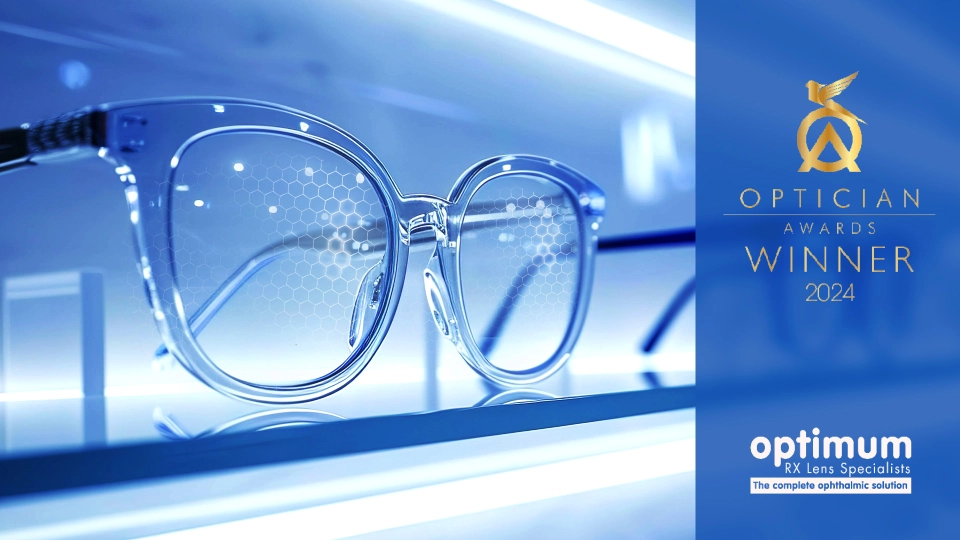
Single-Vision vs Progressive Lenses: Understanding the Difference
- Understanding single-vision lenses
- Understanding progressive lenses
- Progressive lens vs. bifocal and trifocal lenses
- Single-vision versus progressive lenses
- Key differences in application
- Technological considerations
- Pros and cons of single-vision and progressive lenses
- Single-vision lens pros
- Single-vision lens considerations
- Progressive lens pros
- Progressive lens considerations
- Factors to consider when recommending a lens type
- Advanced single-vision and progressive lenses from IOT

Single-Vision vs Progressive Lenses: Understanding the Difference
Navigating the choice between single-vision and progressive lenses extends beyond personal preference—it’s a crucial decision shaped by age, lifestyle, and specific visual requirements. Is a patient experiencing presbyopia? Does a wearer need a multifocal solution with different visual zones or a single corrective focus? Is night driving an issue? Answers to all these questions combined help determine the best lens design on a case-by-case basis.
To determine the best solution, an eye care professional must find that sweet spot between lifestyle, age, visual needs, and lens prescription power. For many, answering that question starts with deciding between single-vision or progressive lenses.
Understanding single-vision lenses
Single-vision lenses correct for a single focal length—far away, intermediate, or close-up distances. Patients who wear this lens have good eyesight at some lengths (like when reading a tourist map of New York City) but struggle with specific focal points (such as viewing the Statue of Liberty from afar). These lenses are best for correcting near-sightedness, farsightedness, or intermediate vision problems.
The technology in single-vision lenses is evenly distributed throughout the entire lens, so the prescription will be the same no matter where the wearer looks through the lens. The flexibility of glasses with these lenses allows the wearer to use them only when needed and then remove them for activities suitable for their natural eyesight.
Understanding progressive lenses
Progressive lenses, also known as multifocal or varifocal lenses, are designed to address multiple vision needs seamlessly. These lenses cleverly transition through varying optical powers, offering a smooth visual experience from one distance to another.
The top part of the lens focuses on distant objects, the middle part clarifies intermediate objects, and the lower third handles reading and close-up vision. The lenses gradually morph around 25 different powers into one lens, seamlessly transitioning between powers. There is no visible line between the various strengths, giving the illusion that the lens is one strength.
Typically, people with presbyopia—an age-related weakening of vision—wear progressive lenses. However, people of all ages, even children, can benefit from this technology if they have eye focus or muscle issues, such as accommodative dysfunction or binocular vision problems.
Learn more: What Are Progressive Lenses and How Do They Work?
Progressive lens vs. bifocal and trifocal lenses
While all three lens types correct vision at multiple distances, they differ significantly in design, technology, and user experience. Bifocal and trifocal lenses are considered the predecessors of progressive lenses, and they feature distinct visual sections separated by visible lines.

Bifocals are lenses with a magnifier at the bottom for reading. They help a wearer bring distances into focus and gaze through the bottom magnifier for reading. Additionally, there is a visible line dividing the top and bottom magnification of the glasses, which can lead to the feeling of “image jump.” Bifocals have only two power zones, improving distance and near vision issues, but struggle to bring objects at intermediate distances, like a computer screen, into focus.
Trifocals add a middle magnifier to sharpen vision at the intermediate distance. This third magnification adds another bifurcated line to the lens, creating a stark image jump when the eye moves between the different zones.
Progressive lenses eliminate visible lines and smoothly transition between multiple powers, eliminating image jump issues. This transitional gradient removes the abrupt changes associated with bifocals and trifocals. Compared to bifocals and trifocals, images appear more natural as there is no hard break between powers and visual distances.
Single-vision versus progressive lenses
The choice between single-vision and progressive lenses becomes clear after establishing a wearer’s lifestyle and visual conditions. It’s less a choice for an eye care professional and more about identifying the correct markers that determine the right path. Recognizing the main differences between these lenses influences the optimal solution for the patient.

Key differences in application
- Single-vision lenses:
- Ideal for wearers needing correction for a single type of visual defect
- Often, the go-to choice for younger patients or those with concentrated specific tasks, like working at a computer or reading
- Some examples of use cases are night driving, occupational needs, reading, and correcting myopia
- Progressive lenses:
- Ideal for multifocal correction, especially for presbyopes
- Offer the convenience of a single pair of glasses for all distances, eliminating the need to switch between multiple pairs
- Helpful in youth with adaptation issues
Technological considerations
Technological Considerations
- Visual Clarity: Due to uniform power distribution, single-vision lenses provide superior clarity at their designated distance. Progressive lenses, while versatile, may introduce peripheral distortions, especially at higher prescriptions.
- Adaptation Period: Single-vision lenses have no adaptation period, making them particularly user-friendly. Progressive lenses may require a brief adjustment period for wearers to acclimate to navigating the different zones.
- Cost Implications: Incorporating advanced technology comes with a higher initial cost, making progressive lenses more expensive per pair. However, they offer long-term cost-effectiveness compared to single-vision lenses by eliminating the necessity for multiple glasses.
Pros and cons of single-vision and progressive lenses
Understanding the advantages and disadvantages of single-vision and progressive lenses is essential for providing the best care to patients. Each type of lens has its own set of benefits and drawbacks.
Single-vision lens pros
1. Clarity and sharp image
Single-vision lenses excel at correcting visibility issues at one specific distance. They address a single focal point, ensuring sharp and clear vision for tasks such as reading or driving.
2. Cost
Single-vision lenses have only one magnification and don’t need to be specially customized, so they are typically less expensive than progressive lenses.
3. Easy adaption
A wearer needs to adapt to the new visual correction at only one focal point within the lens. The eye can easily glance through any point within the lens for greater clarity when reading, for example. The simplicity makes getting used to single-vision lenses easier from the wearer’s perspective than multifocal lenses requiring eye training.
Single-vision lens considerations
1. Limited flexibility
Single-vision lenses correct vision at only one distance, making them less versatile for people who need vision correction at multiple distances. People who struggle with vision at various distances need a more adaptable lens.
2. Not relevant for presbyopes
Patients who require vision correction for both near and far distances often find switching between multiple pairs of glasses inconvenient and cumbersome.
Progressive lens pros
1. Versatility
Progressive lenses correct multifocal vision issues within a single lens. Older presbyopic patients who look at changing distances consistently throughout the day, like a 55-year-old stage manager who reads the script and looks up consistently to watch the actors or a CEO who glances between his computer and coworkers in a meeting, can do so more easily with progressive lenses than with a bifocal or trifocal.
2. Convenience
Instead of switching between multiple single-vision lens glasses, a patient only needs to manage one pair of progressive lens glasses. One pair of progressive lens glasses can be less expensive than buying multiple single-vision lens glasses at different prescriptions.
3. Modern design
Progressive lenses have no visible lines separating the focal areas, offering a more aesthetically pleasing appearance than bifocals and trifocals.
4. Sports compatibility
Athletics and sports can be tricky for presbyopes who struggle to see at multiple distances. It isn’t helpful to only see a tennis ball right before it hits the racket. Progressive lenses can help an athlete keep their head in the game by bringing the field of play into focus.
5. Personalization
Manufacturers can customize progressive lenses using freeform using advanced technologies, such as Digital Ray-Path 2, Steady Plus, and Camber. These technologies optimize lens surfaces for all gaze directions, enhance stability, and combine complex curves to deliver excellent vision at all distances, perfectly tailoring each lens to the individual’s lifestyle and visual needs.
Progressive lens considerations
1. Adaptation period
Progressive lenses can require an adjustment period as patients learn to navigate the different focal areas within the lens. This adaptation can sometimes be challenging.
2. Peripheral distortion
Some wearers may experience peripheral distortion when looking through the sides of progressive lenses. The patients feel like they’re ‘looking through water,’ with blurred edges softening the look of everything. This issue can be more pronounced in higher prescriptions.
3. Cost
These lenses have complex technology wrapped within them, which results in a higher upfront cost. Sometimes, progressive lenses can cost 3-4x more than single lenses. Patients with a strict budget may be unable to afford the high sticker price.
Factors to consider when recommending a lens type
What does your patient do for work? Are they consistently looking at various distances throughout their day, or do they hyperfocus on one activity for a long time? How flexible does one pair of glasses need to be for them? Determining if the wearer needs to solve one or multiple vision issues can affect the best lens choice.
1. Patient hobbies and daily activities
Assess the patient’s daily routines and activities. Consider whether they need clear vision at various distances throughout the day or need to focus on one specific task for extended periods. This will help determine whether they need lenses that provide a broad range of vision corrections or lenses optimized for particular tasks.
2. Patient age
Younger patients may not need multifocal correction, whereas older patients often require lenses that address presbyopia and other age-related vision changes. The lens choice should reflect the patient’s age-related vision needs and ensure comfortable vision correction for their daily activities.
3. Comfort and adaptation period
Consider how easily the patient can adapt to new lenses. Some lenses may have an easier adaptation period, while others require more time for the wearer to get accustomed to the different vision zones or specialized features.
4. Budget
Evaluate the patient's budget. Lens technology and customization can vary in cost. Some lenses might have a higher initial cost but offer long-term benefits, reducing the need for multiple pairs of glasses. It's important to balance cost with the functionality and benefits provided by the lenses.
5. Specialized needs
Identify any specific visual requirements, such as lenses for driving, reducing eye fatigue, or accommodating multiple focal points. Technologies like Digital Ray-Path 2, Steady Plus, and Camber can enhance the performance of both single-vision and progressive lenses, providing tailored solutions for different visual tasks.
Luckily, the optical industry has a plethora of custom and specialized choices to meet any patient’s needs. The advent of new technology and cutting-edge lens designs allow precise visual corrections that tackle any unique blend of vision and lifestyle factors.
Advanced single-vision and progressive lenses from IOT
IOT doesn’t settle for standard - Our lenses push the boundaries to deliver exceptional results.
We understand that even a patient needing only one lens power might need a little extra help. So we offer anti-fatigue single-vision lenses and driving single-vision lenses on top of our standard single-vision. Our progressive lens solutions can take on even the most specific patient requirements. From lenses boosting a particular distance to accounting for outdoor activities and accommodating airline pilots’ needs, we have the technology to elevate your practice.
You might also like: 8 Types of Progressive Lenses
Want to know more about our lens technology at the forefront of the eye care industry? Fill out the form below to see what IOT can do for your lab or optical business.






